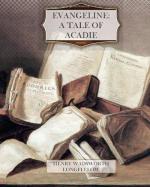STUDY OF THE TEXT.
(1.) Lessons I-XXVII.
(2.) Composition Subjects.
The questions on the following pages are intended to be suggestive of lines of study. Others of like or different import will occur to the teacher. Don’t be confined to the written questions. Many others will be needed to bring out the artistic and spiritual values of the poem and to keep the thread of the story in mind.
Pupils are expected to know the meaning of words and the particular one the author employs. The understanding of a passage often depends on the meaning of a single word. (See Part III.)
SUGGESTIVE QUESTIONS.
EVANGELINE—PART I.
SEC. I.
Introduction. Grand Pre.
Lesson I, Lines 1-57.
The author gives us a hint of the nature of his narrative. In what lines does he directly refer to it? This is a story of what? What three qualities had this thing? What two pictures does the author contrast, lines 6-15? Why murmuring pines? What two parts of one picture, lines 1-5? Why compare to the roe? In what ways did their lives resemble a river? Why October leaves? Remember—this is a story of what? Its three qualities are what? What is the first picture in Section I? What quality of the people is referred to in line 24? The Acadians were engaged in what industry? Would their lives be more peaceful in this than in other lines of labor? Why use reposed, line 32? Who was intimately associated with all the life of the village? Explain lines 52-56 and 57.
Evangeline.
Lesson II, Lines 58-81.
What is the topic of this lesson? Who is also
introduced to us? Describe.
What does the comparison with an oak suggest?
What was Evangeline’s age?
Describe her appearance. What qualities does
this description show of her?
What was Benedict’s most marked characteristic?
Evangeline’s?
Home and Childhood of Evangeline and Gabriel.
Lesson III, Lines 82-147.
Why does the author describe the home so carefully? What do we learn of Evangeline, lines 104-114? What two characters are here introduced? Tell about their childhood days. Note the early attraction of these two for each other. What about the wondrous stone? Have stones such powers? Evangeline’s name (line 144) indicates what?
SEC. II.
Autumn. Evening Out-of-doors. In-doors.
Lesson IV, Lines 148-198.
What is the season? What is the sign of the scorpion? What season follows? Signs point to what? Why should the author refer to signs of a hard winter? What idea does the author reiterate, lines 160-175? Note—the author brings up one picture after another to impress us in this way. Why? Does he picture the home clearly? Describe. What things of old time life does he mention? Give topic, lines 199-217. Where were the Norman orchards? What does the loom suggest?




